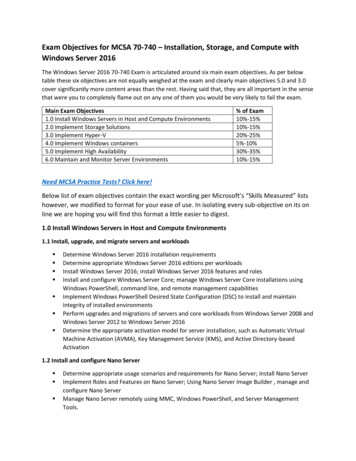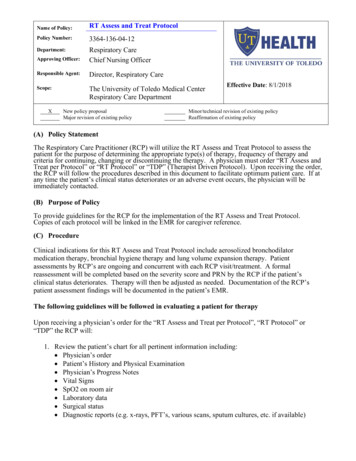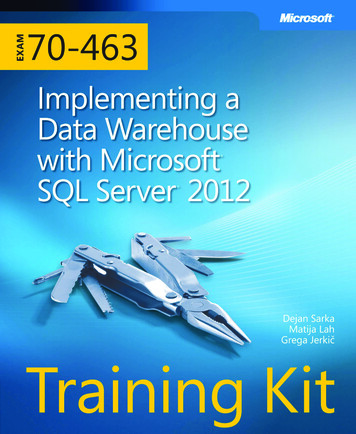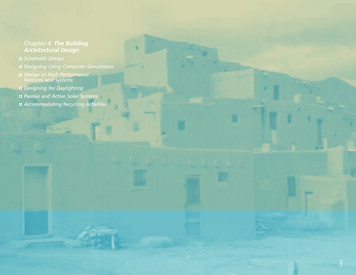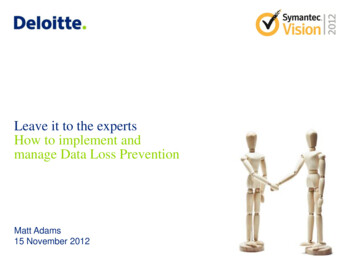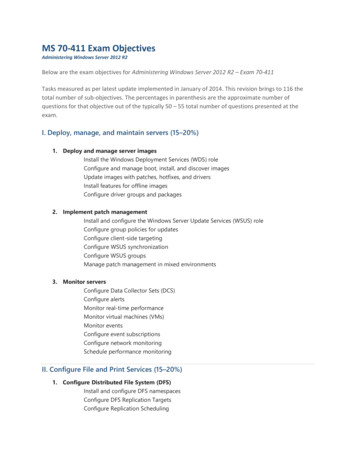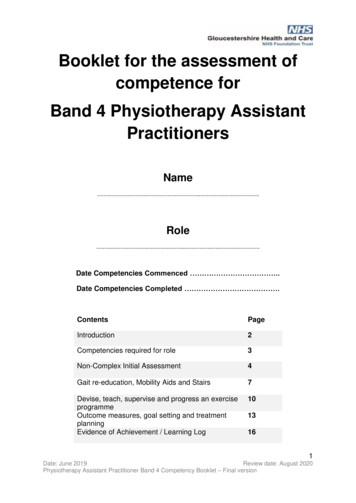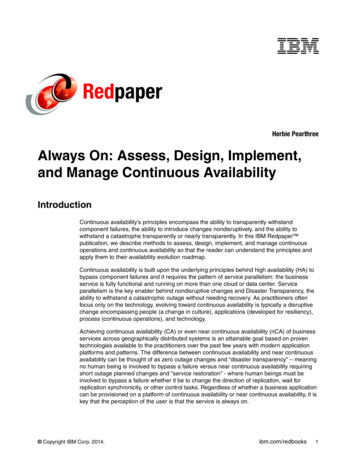
Transcription
RedpaperHerbie PearthreeAlways On: Assess, Design, Implement,and Manage Continuous AvailabilityIntroductionContinuous availability’s principles encompass the ability to transparently withstandcomponent failures, the ability to introduce changes nondisruptively, and the ability towithstand a catastrophe transparently or nearly transparently. In this IBM Redpaper publication, we describe methods to assess, design, implement, and manage continuousoperations and continuous availability so that the reader can understand the principles andapply them to their availability evolution roadmap.Continuous availability is built upon the underlying principles behind high availability (HA) tobypass component failures and it requires the pattern of service parallelism: the businessservice is fully functional and running on more than one cloud or data center. Serviceparallelism is the key enabler behind nondisruptive changes and Disaster Transparency, theability to withstand a catastrophic outage without needing recovery. As practitioners oftenfocus only on the technology, evolving toward continuous availability is typically a disruptivechange encompassing people (a change in culture), applications (developed for resiliency),process (continuous operations), and technology.Achieving continuous availability (CA) or even near continuous availability (nCA) of businessservices across geographically distributed systems is an attainable goal based on proventechnologies available to the practitioners over the past few years with modern applicationplatforms and patterns. The difference between continuous availability and near continuousavailability can be thought of as zero outage changes and “disaster transparency” – meaningno human being is involved to bypass a failure versus near continuous availability requiringshort outage planned changes and “service restoration” - where human beings must beinvolved to bypass a failure whether it be to change the direction of replication, wait forreplication synchronicity, or other control tasks. Regardless of whether a business applicationcan be provisioned on a platform of continuous availability or near continuous availability, it iskey that the perception of the user is that the service is always on. Copyright IBM Corp. 2014.ibm.com/redbooks1
The basic technical concept that enables continuous availability and near continuousavailability is the ability to run a service from multiple “clouds” in parallel (also known asservice parallelism). Each “cloud” is capable of running the business service independently ofits peers, yet replicates state and persistent data to its peer “clouds”. Enabling the IT platformis as straightforward as implementing the three enabling technologies: Global traffic management, which intelligently routes users to one of the service “clouds” Non-persistent application data grid where sessions and non-persistent data can bereplicated across “clouds” Guaranteed application level data replication, which enables data to persist in all cloudswhether it fits the requirements of Atomicity, Consistency, Isolation, and Durability (ACID)– typically a requirement in the financial sector or eventual data consistency, which fitsmost other sectors (similar to the Google, Bing, Facebook, eBay, and so on)Eventual data consistency is not a new concept, because the concept of memo-post or storeand forward has been practiced in the financial sector since the advent of automated tellermachines. Yet unless the business services application architecture, development, andoperations processes are designed to take advantage of the flexibility and constraints of thecontinuous availability IT platform and availability patterns, the business availability goals willnot be met.Brewers CAP Theorem on distributed systems limits the technology solution to providing onlytwo of the three guarantees: Consistency: All distributed nodes have a single up-to-date copy of all data at all times. Availability: Every request receives a success/failure response. Partition tolerance: System continues to run despite arbitrary message loss or failure ofpart of the system. For example, the network, stops delivering messages between serversets.Given Brewers’ limits, it is extremely important to accurately assess the businessrequirements of every business service to determine which architectural pattern to apply toeach specific service based on business requirements. In addition to the businessrequirements, the application architecture and platform must be assessed to best determinehow to mitigate whichever of Brewers’ three guarantees cannot be met. It is also important toconsider these limitations as they apply to the application presentation and business logiclayers (also known as the systems of engagement) independently of the data layer (also knownas the system of record). A common pattern might have the application pattern accepting theconsistency risk although the data layer might not be able to risk consistency and thereforemust choose to accept the availability risk. After the design is correctly assessed, the designphase begins and establishes the application, data, and the IT platform patterns toimplement.In parallel with the design phase, the practice of continuous operations must be established tomaintain continuous availability. Typically, this is a disruptive change because the historicalmodel of non-integrated business, development, and reactive delivery silos must be replacedwith a close partnership among business, development, and business service (also known asBiz/DevOps)-aligned proactive delivery teams.2Always On: Assess, Design, Implement, and Manage Continuous Availability
Managing continuous availability and near continuous availability requires zero or near-zerooutage changes and can significantly change the existing incident, problem, and changeprocesses. Take, for example, the IBM website www.ibm.com. Because the delivery teamcan manage zero outage changes even with an agile application development anddeployment model, change management calls and planned changes are performed duringnormal business hours daily. Incident and problem processes must be changed to empowerimmediate bypass of failed components – you cannot wait for a ticket to get routed correctlyand approvals requested before you bypass actions. To ensure that changes are successfuland incidents are immediately handled, delivery operations must understand the businessservice end-to-end, be aligned to the service, and be empowered to take mitigation actions.AssessThere are multiple assessments that must be made to establish the roadmap towardcontinuous availability for our client’s critical business services. We have found manyexamples of organizations that vary in their maturity and readiness to evolve to extreme levelsof availability. Before designing a continuous availability or near continuous availabilitysolution for a business service, it is imperative to assess the business service requirements,applications, and processes, and the organization’s current state of maturity. The basicpremise is that they must start with HA and disaster recovery (DR) – this seems somewhatobvious but it is clear that many organizations in the financial sector are bound to back-officesystems based on technologies common in the 1980s, which inhibit their journey beyondHA/DR. It is imperative that assessments dive deeply into each technology domain andinvolve experts in each. These assessments must span people, process, applications, andtechnology – with people and process being the most time-consuming and difficult to change.Assess the business service requirements for availabilityMany organizations are already aware of their most critical business services, especially ifregulatory requirements or business requirements have mandated DR solutions for those.However, often the business is driven from the Chief Marketing Officer (CMO) and CxO levelswhere they believe everything must be always on. This non-functional requirement is drivenby the knowledge that from a user perspective, the service must always be there, regardlessof time of day. This perspective is valid because consumers access services, anytime,anywhere. However, it is not feasible, both from a technology perspective and a costperspective to enable every business service to be always on. For a business serviceapplication to ride on a continuously available platform, it must be modernized – often adisruptive leap that requires significant development funding, extensive testing (“know how itworks, know how it fails”), and an integrated operations model. Therefore, we must helporganizations identify and focus on their most critical business services first so they know howto direct their funding.Let us look at an example based on an international airline availability assessment. On initialinvestigation, discussions with the CMO indicate that the ability to sell tickets and upsellservices is the most important business service. The Chief Operations Officer’s criticalbusiness driver is “Keep the planes on schedule and in the air”. The CIO’s perspective is tokeep all the systems available as much as possible.Given the broad perspectives represented at the CxO-level interviews, the assessmentapproach recommended development of “use cases” that are representative of the corebusiness functions that support the airline’s daily operations so that each of the scenariostraverses across multiple members of the top critical IT systems groups.Always On: Assess, Design, Implement, and Manage Continuous Availability3
The following IT systems groups were defined: Flight operationsDeparture control systemAirport operationsAircraft maintenanceCrew operationsElectronic communicationsReservation systemThe following use cases were identified: Print boarding passScan boarding passRelease a flightReroute aircraftPurchase seatCheck in passengerElectronic communicationsWith these use cases, interviews and data collection activities identified twenty-ninesupporting applications, environments, and infrastructures that compose the foundationalsupport of the airline operational IT architecture. These became the focus of the availabilityassessment.See Figure 1 for the business criteria categorizations – the color nomenclature is used asclients have various terms for identifying business criteria categories. See Figure 1 for anoverview of the categories.Figure 1 Business criteria categorizations4Always On: Assess, Design, Implement, and Manage Continuous Availability
Assess the business service application architectureCan the application take advantage of the technologies that enable continuous availabilityand mitigate the missing Brewer’s Theorem guarantee? Although this might sound like asimple question, the answer can be complex. Many existing applications have evolved overtime through business requirements, acquisitions, consolidation, and so on. Many havenumerous dependencies and numerous interfaces that all must be evaluated. Often, thebusiness might not even be aware of all the dependencies and interfaces even though theyare tightly coupled and must be included due to that tight coupling. The applicationassessment must include discovery of these dependencies and interfaces, and identify theapplication availability patterns that fit.Just like assessing business services applications’ readiness for cloud adoption, assessingand evolving applications for higher levels of availability might be difficult and might cause adisruptive evolution. Both cloud and continuous availability patterns fundamentally change therelationship between an application and its computing resources. Both are platformsdesigned for the non-functional requirements underneath a business application.There are two adoption strategies for cloud and continuous availability patterns thatenterprises must adopt: Cloud/continuous availability-ready applications can be adopted to run in a private cloudor continuous availability platform. Cloud/continuous availability-centric applications are natively built for the cloud orcontinuous availability platform with a different set of assumptions.Cloud/continuous availability-ready applications are often built without cloud assumptions inmind. They are deployed using existing standard technologies, such as Java/Java Platform,Enterprise Edition and relational databases, for example. In the case of cloud/continuousavailability-ready applications, applications only need minimal knowledge of topology – followJava Platform, Enterprise Edition best design practices or SQL best practices, for example.However, they require different enabling technologies to take advantage of capabilities, suchas synchronization and auto-scaling, and must be updated to support the non-functionalrequirement of continuous availability. Granted, not all traditional or historical technologiescan fit continuous availability patterns and therefore will remain, at best, HA with fast failover.Cloud/continuous availability-centric applications are built for the platform and assume thatindividual components are untrustworthy, temporary, and will fail. They assume that all workmust happen in distributed clusters (not stretch clusters) and are built by composition. Theapplication must be fully aware of the platform topology to take advantage of the technologiesthat enable automatic fault transparency, and state and data replication methods. Theapplications must also handle resiliency – what used to be a non-functional requirement,failing gracefully without impact, and in some cases making up for the deficiencies in what theplatform can deliver. This awareness usually requires a rewrite of an application because theexisting applications do not meet the “shared nothing” and synchronization requirements ofcloud and continuous availability platforms.Several practices are provided that assisted with this assessment in previous clientengagements.We learned that it useful when decomposing an application’s readiness and abilities formoving to a more available platform, to start simply and dive deeper. Often, evolving theapplication’s presentation or business logic layers (systems of engagement) is not difficultbecause the layers are not so tightly coupled to the data. The challenge comes down to thedata layer. Here, we have to focus again on the data requirements: absolute or eventual dataconsistency and the RPO.Always On: Assess, Design, Implement, and Manage Continuous Availability5
First, we must talk about application architectures because not all applications are designedto take advantage of the availability patterns provided by technology. This is a criticalassessment step because many clients purchased applications from vendors where theyhave little control over development requirements. Therefore, we must fit the solution to thelimitations of the application. Where the business controls the application development, theycan fund the development to support either the Active/Query solution to provide nearcontinuous availability or the Active/Active solution to provide continuous availability.Figure 2 is helpful in explaining the application resiliency patterns to organizations planningtheir evolutions. It is important to inspect these application patterns with the keyunderstanding that the requirements for the systems of engagement (the presentation andbusiness logic layers) might be evaluated independently of the systems of record (the datalayer). In most cases, systems of engagement have no data consistency requirements andchange most often – a perfect fit for multi-active clusters. These four patterns are presented ina simple way to help assess the application’s existing capabilities and its future bestavailability pattern. Under the description column, note the differences in patterns usingrecovery time objective (RTO) – the amount of time to restore the service and RPO – theamount of possible data loss in a catastrophic situation.Figure 2 Application resiliency patterns6Always On: Assess, Design, Implement, and Manage Continuous Availability
The following architectures are described in Figure 2 on page 6: Active/Standby is the traditional architecture since the first IT failure – old, proven, andcostly for the minimal risk avoidance it provides. Often in practice, keeping the standby“cloud” identical to the active “cloud” is difficult because many organizations choose to usethe standby “cloud” for development rather than having it unused – this practicesignificantly increases their RTO. Advanced organizations use a variant of this pattern forconcurrent application releases, where the active “cloud” will have application version X inproduction, the standby will have version X 1 and they will switch from active to standbyfor production traffic during the change. This operational practice might also be referred toas “concurrent versioning”. This mature operational practice of evolving Active/Standby toactive/warm and integrating into application change and release practices can significantlyreduce planned downtime because the interruption of service is shortened from perhapsmany hours to minutes when cutting over from the active “cloud” to the warm “cloud”. Partitioned Active is one step beyond Active/Standby in that both “clouds” can be usedwith users directed to one or the other “cloud” and there are no application changesrequired. This redirection can be based on geographic location, account number, and soon – the point is that some users do business from one “cloud”, others do it from the otherand they never mix unless there is a catastrophic failure. Data is replicated to each “cloud”in case of a catastrophe where all work can be cut over to the surviving “cloud”. Thispartitioning of users enables the partitioning of data for uni-directional replication, avoidingdata conflicts and ensuring atomic consistency. Like mature organizations usingActive/Standby cutover for concurrent application releases, this same concept can beemployed in the Partitioned Active pattern increasing the potential for zero-outageapplication deployments. Asymmetric Active or Active/Query means that only one read/write database (also knownas systems of record) exists with the replicas being used for read-only workloads. Userscan be served from either “cloud” with all their data reads coming from the local database.Applications must change because they need to share the session state and be aware ofthe routing mechanism to direct writes to the systems of record database, and reads to thelocal read-only replica. There are network appliances available that can intercept the SQLstatements and route them, reducing the impact on application development. Anothermethod is to expose the data layer through a web service and use Layer 7 URI routing onServer Load Balancers or similar appliances to route the reads and writes separately. Likethe previous solutions, mature organizations can also apply zero-outage applicationreleases to this environment by following the same X and X 1 concurrent versioningpractice mentioned previously. Active/Active means that all “clouds” provide the same service, with data reads and writesat any “cloud” synchronized. This method provides transparent fault tolerance, even at the“cloud” level. The service is available in all locations except during planned and unplannedoutages when only one “cloud” provides the service. This level of availability typicallyrequires application changes to ensure that applications generate unique indexes, keys,and so on for data consistency. Therefore, this architecture is perhaps the most expensiveand difficult to implement due to software development costs.Always On: Assess, Design, Implement, and Manage Continuous Availability7
Designing for continuous availabilityIT architects are well practiced in the art of designing infrastructure platforms based oncommon technologies and patterns, including HA. However, in the past they have been givenbusiness requirements that only address functional requirements, for example, Windows.NET environment, Oracle WebLogic Java Platform, Enterprise Edition environment, IBMWebSphere Java Platform, Enterprise Edition environment, Mainframe CICS/IMS/IBMDB2 , and so on. In the past, the architectural decisions made did not consider any of themethods that enable higher levels of availability because the Active/Standby and DR solutionsare independent of those methods. When considering a design for continuous availability ornear continuous availability, the architect must first address the non-functional requirement ofcontinuous availability of the platform and map that back to the business functionalenvironmental requirements. This is a disruptive thought in the practice of the IT architecturebecause it requires architects to think differently, and the business application to comply withthe requirements mandated by the availability platform.Although availability requirements might be considered non-functional, they are absoluterequirements when designing for continuous availability. The platform solution options aretightly coupled to the application availability patterns discovered during the previous assessphase of requirements gathering. The solution will also be based on the capability of themiddleware and the database platforms to replicate the state and data, ensuring serviceparallelism from the “clouds”.Rather than focus on the hundreds of product and pattern designs available, we must insteadestablish some guiding principles to the design phase and leave it to the practitioners tointegrate the platform-specific requirements. Platform-specific requirements are welldocumented for every platform and must be followed, assuming they are updated to supportcontinuous availability patterns.Continuous availability design guideline principlesThe guiding principles behind HA design are a prerequisite to the principles listed: Continuous availability’s core principles encompass the ability to transparently withstandcomponent failures, the ability to introduce changes non-disruptively, and the ability towithstand a catastrophe transparently or nearly transparently. Always keep that in mind. Think differently: The principles listed might sound counterintuitive but they have beenproven successful in many cases. The IBM http://www.ibm.com website that has beenactive continuously since June 2001 is the case study for these principles. You will findsimilar principles followed in all other mature organizations where continuous availability isthe guiding principle in the organization (for example, Google, Facebook, eBay, Amazon,USAA, and so on). Keep it simple, stupid (KISS): It is easy to add complexity into any solution, even solutionswhose goal is to achieve outstanding levels of availability. Complexity adds obfuscationand difficulty during problem resolution and adds more points of failure.8Always On: Assess, Design, Implement, and Manage Continuous Availability
Include concurrent versioning in the design: The ability to run concurrent versions ofapplications or platforms might be a design principle from HA design. However, in manycases, we have found organizations unable to perform concurrent versioning due toarchitectural design limitations.The concurrent versioning solution can be two clusters within a “cloud” allowing staggereddeployments, or the solution can even be enabled by staggering different versions per“cloud” in a multi-cloud configuration (such as Google, Facebook, and many others).Business requirements will drive the longevity of versioning. The duration that applicationrelease version N and version N-1 may (or must) coexist will be driven by businessrequirements and therefore will drive the architectural decisions. Include the capability to perform continuous operations in the design: This principle issimilar to the “Include concurrent versioning in the design” principle because it enablesoperations to change anything at any time without affecting the business service.Versioning addresses application releases, middleware updates, OS updates, and otherchanges. You must also design to facilitate concurrent infrastructure maintenance,network maintenance, and component maintenance. All systems must be continuouslyupdated for security and resiliency purposes, so the design must enable that concurrently.The simplest example is at the network layer where devices are typically deployed in pairs,upgrades are done one device at a time without interrupting the service. Middlewarecluster technology is another example where clusters are made up of N 1 nodes so thatany node in the cluster can be taken offline for maintenance without affecting the rest ofthe cluster. Design the solution as though only one “HA cloud” exists: This might sound like anoversimplification, but it is necessary to reinforce this fact because we have to rememberthat we must design for the business application environment identified during a BusinessImpact Assessment. All the difficulty that comes into designing a typical data center or“cloud” still exists – no single points of failure can exist (although architectural decisionsmight conclude that you do not need HA pairs – more on that later). You will tie the“clouds” together with technologies described later and either dedicated circuits or virtualprivate networks (VPNs) to allow the clouds to stay in sync. After the design is finalized forthe functional requirements, we can then clone that design for the other “clouds” for theparallelized business service. Remember, we want each “cloud” to be able to completelyfunction on its own and to also be able to replicate its state and data with its peers. Fail small: Everything breaks, so we need to ensure that the failure affects as few users aspossible. Horizontal scaling addresses this principle well, but many organizations haveworkloads that need to scale vertically. Often, this is a dilemma to be solved by thearchitect and operations teams, but we need to address this in the design phase to enablethis principle. We have seen a case study where an organization had deployed nearly 500virtual machines (VMs) on the same physical frame – although plausible in practice, therisk of a frame failure now affects 500 VMs. Additionally, by embracing virtualization formobility (the next principle), you will be required to design sufficient spare compute andmemory so that all workloads can be moved off a frame for frame maintenance. The largerthe frame, the more unused space you will pay for in reserves. Virtualize nearly everything: Virtualization provides flexibility and mobility, both enablers ofcontinuous availability and near continuous availability. Virtualization flexibility enables youto scale up and scale out as needed. Mobility enables you to evacuate a frame for framemaintenance. Although the promise of concurrent hardware and software maintenance iscoming to fruition, mature organizations will proactively move all services off a framebefore they perform even “concurrent maintenance” to avoid the risk of it not working.Virtualization of course goes beyond the compute domain. Many networking, security,application accelerator appliances, and storage solutions support virtualization (forexample, Software Defined Environments (SDEs)).Always On: Assess, Design, Implement, and Manage Continuous Availability9
Automate nearly everything: The leading cause of unplanned outages is the combinationof people (40%) and processes (40%). Hardware and operating systems are only 20% ofthe problem. This 80% encompasses the application realm, as well as the people andprocesses that create the applications. Automation ensures that precise, repeatable tasksare performed in the correct order, avoiding human error. Automation also allows theautomatic bypassing of failed components and services far faster than any human beingcan respond. Remember that if a business has the expectation of a 99.99% service levelagreement (SLA) on a business service, then only 4 minutes of downtime are allowed amonth. Have you ever seen a person respond to an incident in 4 minutes? There might bepolicies where you require a human being to act rather than use automation. Take, forexample, bypassing an intermittent or partial failure. Although automation canautomatically bypass an intermittent issue, it is possible that it might bypass everything fora badly misbehaving application and therefore bring down the business service in error.Design for automation, and grant exceptions to align with business policies. Design for failure, which is also known as “Know how it works, know how it breaks”:Everything breaks, so we need to ensure that our design considers this principle. Themost mature organizations fully embrace this principle. Netflix, for example, has the“Chaos Monkey” that breaks random things to ensure that the service continuesuninterrupted. If it interrupts service, the platform design or application must be changedto mitigate that situation the next time. At the most primitive level, this principle can beaccomplished using the “cleaning person” method: walk on the data center floor, unplugsomething at random, and see what happens. When integrating services across “clouds”,it is extremely important to know how the technologies that allow integration fail – we mustavoid using a technology that spreads the failure domain beyond individual “clouds” toachieve extreme levels of availability. Applications must also be designed for failure: Everything breaks; repeat this fact threetimes. Complex applications might have dependencies that are external to the continuousavailability platform that are at best HA. If an external service fails, the application musthandle this transparently. Rather than the entire application failing due to the weakest link,it must gracefully mitigate the failure or inform the
Cloud/continuous availability-centric applications are natively built for the cloud or continuous availability platform with a different set of assumptions. Cloud/continuous availability-ready applications are often built without cloud assumptions in mind. They are deployed using existing standard technologies, such as Java/Java Platform,

